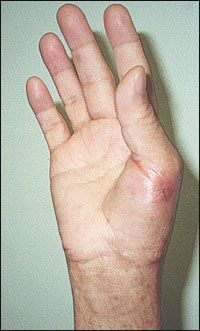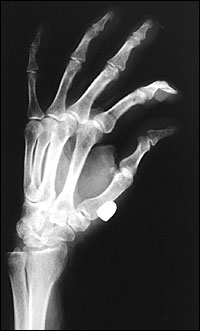
Am Fam Physician. 2003;67(7):1567-1568
A 65-year-old woman presented to the clinic with pain, swelling, and redness of three weeks' duration in her right hand. The patient was putting clothes to dry on a line in her backyard. When she raised her hand, she felt a sudden onset of pain at the radial aspect of her right hand. Subsequently, this area became red and swollen. She went to the emergency department the following day and was given oral antibiotics. Her condition did not resolve. Physical examination revealed a lesion on the right hand near the first metacarpophalangeal joint (Figure 1). There was swelling, tenderness, erythema, and slight purulent discharge from the lesion. Radial pulse was normal. Sensation to touch was normal in the hand and was slightly decreased over the swelling. There was marked decrease in the range of motion at the metacarpophalangeal joint.

Question
Discussion
The answer is C: subcutaneous foreign body, which was revealed by radiograph to be a bullet injury to the right hand (Figure 2). The unusual point is that the patient did not realize she had a bullet injury at the time of injury. There was a small entry wound, and the bullet got lodged in the hand. The wrist bones were not fractured. The superficially buried bullet was successfully removed in the clinic. Eventually, the patient recovered completely and had full range of motion of her hand.

According to a Centers for Disease Control and Prevention study, there were 38,505 firearm-related deaths in 1994. It is estimated that there are approximately three nonfatal firearm injuries for every death associated with a firearm.1
A spider bite is a possibility because the patient was outdoors and recalled an acute onset of pain. The erythema and swelling also would be typical, but not the duration of symptoms or the marked loss of joint function.
In infectious tenosynovitis, an infected puncture wound or laceration tracks to an adjacent tendon sheath and is a true orthopedic emergency. This can be distinguished from a simple localized abscess by the presence of intense pain with any attempt to move the affected tendon. In the case of the local abscess, typical thumb movement could be accomplished without much pain.